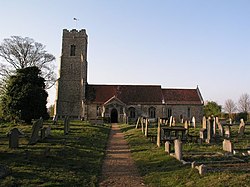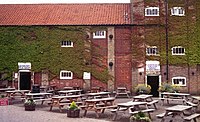Snape, Suffolk
| Snape | |
| Suffolk | |
|---|---|
 St John the Baptist, Snape | |
| Location | |
| Location: | 52°10’12"N, 1°30’0"E |
| Data | |
| Local Government | |
Snape is a small village in Suffolk, on the River Alde close to the coast at Aldeburgh. It has about 600 inhabitants. Snape is now best known for Snape Maltings, no longer in commercial use, but converted into a tourist centre together with a concert hall that hosts the major part of the annual Aldeburgh Festival.
Another remarkable feature of Snap is the Snape ship burial, an Anglo-Saxon ship burial from the sixth century uncovered here, which has yielded a trove of Anglo-Saxon art.
The name 'Snape' is Old Norse for a boggy tract of uncultivated land, which described well the marshlands by the Alde before the land was drained.
Early history
In the Roman period a village was established a settlement here, centred on salt production.
In Anglo-Saxon times, during the Kingdom of the East Angles, a burial ground was established at Snape, possibly a royal site given the richness of the graves excavated. Archaeological investigations have revealed boat burials and other graves.
The original village stood on higher ground, around the present church, later moving down nearer to the river. In 1085 the Domesday Book recorded forty-nine men. The book also mentions a church, standing in eight acres, and valued at sixteen pence. The present church, however, originally thatched, was built in the 13th century, with the 15th-century additions of a porch and tower.
Snape priory was founded in 1155 downriver from the village, by William Martell, a local landowner, who was about to set off as part of the Third Crusade. It survived until 1525, when it was closed and stripped of its wealth, not during the general dissolution of monasteries carried out by the King and Cromwell eight years later but by Cardinal Wolsey. One of its barns, built by the monks, is all that still stands, and has been dated to 1295.
The monks also built a water mill, and probably also constructed the first bridge across the Alde. This was wooden at first, though in 1802 a brick bridge was built, and then itself replaced in 1960.
In the 15th century Snape (with a population of under 500) shared its own rotten borough Member of Parliament for "Snape-cum-Aldeburgh".
Trade
Snape has had five main industries throughout its history. Under the Romans it was salt production, but in the 19th century it was fertiliser, created from coprolite found locally. The discovery of the commercial viability of this process (by a Saxmundham bone merchant, Edward Packard) led to what has been dubbed "the Suffolk Gold Rush", and local fortunes were made (Packard established what was to become the fertiliser company Fisons, now part of AstraZeneca).
Sugar beet was also an important product; it was first grown commercially in and exported to the Netherlands from Snape. The Maltings, producing and exporting high-quality malted barley, was a fourth important industry, which bequeathed buildings to the fifth significant industry: tourism.
Snape had already tasted success as a tourist destination, for in the 18th and 19th centuries the Snape Race Course on the banks of the Alde was the site of a race meeting held every year for nearly 150 years. This led to the building of a new road (now the A1094) by the Aldeburgh Turnpike Company, which made Snape easy to get to, and which continued to be the main route to the village even after the coming of the railways (which reached Snape in 1888, though only for goods traffic to the Maltings).
As a result of fertiliser, sugar beet, and malted barley, Snape had become a very busy inland port by the end of the 19th century. The Snape Maltings closed as a commercial maltings in the 1960s but with its fine brick buildings and pretty riverside position, was ideally suited for redevelopment as a tourist centre and now constitutes the main industry in the village. In particular, the famous Aldeburgh Festival is now held in the Maltings, emphasising the area's links with Benjamin Britten.
Outside links
| ("Wikimedia Commons" has material about Snape, Suffolk) |
- Parish Council maintained site for Snape
- Snape at nearthecoast.com ... it's a little bit Suffolk
